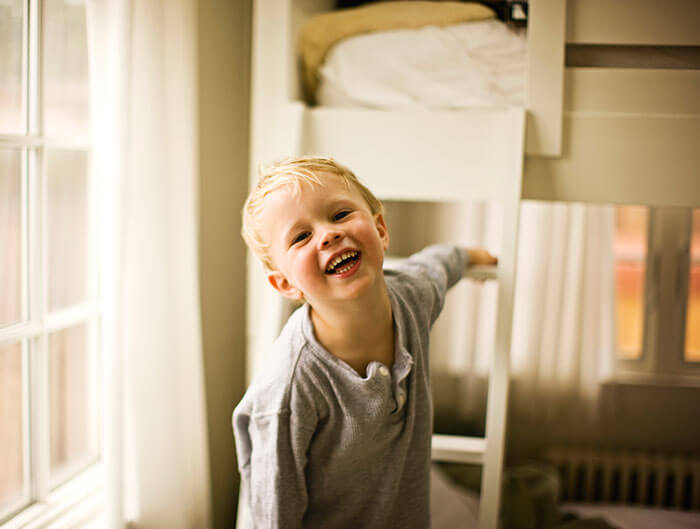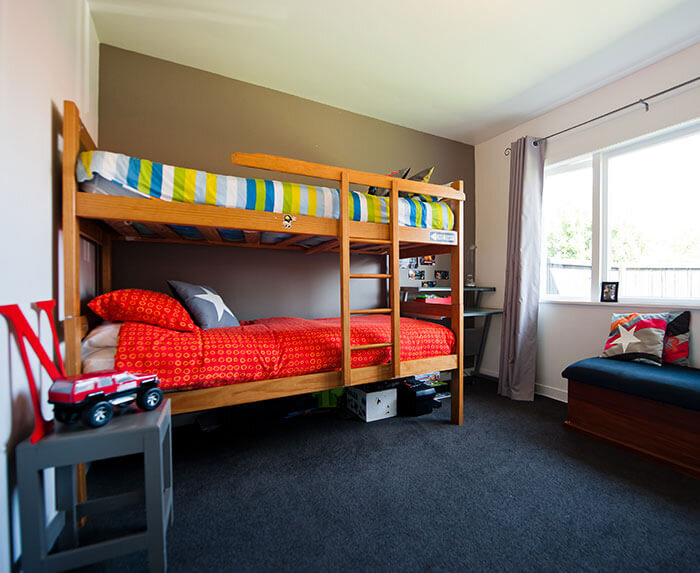Consider The Safety Of Bunk Beds and What To Look Out For
If you have siblings, you likely have fond (or maybe not so fond) memories of bunk beds. Bunk beds are the perfect piece of furniture for families that have multiple children, but limited space. Plus, up until a certain age, many kids love bunk beds. Interestingly, bunk beds aren’t a recent invention.
While it’s difficult to pinpoint its exact appearance, it looks like bunk beds appeared back in the medieval times to save space and really gained steam with the military since they could fit twice the amount of soldiers in the same amount of space. It wasn’t until the 1980s that it became popularized for homes thanks to being featured on TV shows and movies.
Today, bunk beds have become a staple for many homes. While it offers plenty of benefits, it also has drawbacks. If you’re thinking about getting a bunk bed for your kids, you might want to consider the safety tips of these beds, especially if your children are young.
What are bunk beds?
You’ve probably slept on a bunk bed as a child or maybe you lived in a college dorm that used bunk beds. Regardless, these beds have become ubiquitous in homes, barracks, and colleges alike. Essentially, bunk beds are a type of bed where one bed frame is stacked on top of another allowing for two or more beds to occupy the same amount of floor space.
Kids Bunk Beds
Bunk beds are usually supported by four poles or pillars at each corner of the bed. There’s generally a ladder that allows people to get to the upper bunk.
One of the biggest drawbacks of a bunk bed is the lack of privacy, but you can either get a model that has a privacy curtain or create one yourself. There are also many other models that change up the standard bunk bed arrangement by putting the top bed perpendicular to the bottom one, having actual stairs instead of a ladder, or having a full bed on the bottom instead of two twins.
Don’t confuse bunk beds with lofts. While they both share the feature of having one of the beds elevated off the ground, loft beds do not have the lower bed. It’s perfect for a child who still wants to be elevated higher off the ground, but don’t want to share a room with anyone else. You can use the space under the bed to set up a desk or play area thus getting the same space-saving benefit.
Dangers For Children
Bunk Bed Safety Tips
As convenient and fun as a bunk bed might be, it’s not without its drawbacks. There are around 36,000 bunk bed-related injuries that occur every year requiring emergency room treatment. Luckily, most injuries are fairly minor and occur when the child falls from the beds either because they are playing on the bunks or they fall off while sleeping.
Of course, there are some that are very serious. If your child falls from the top bunk while sleeping they could get a fracture or concussions. While you can solve this issue by putting up guard rails on the side of the bed, there are issues with the bunk bed structure itself that could result in suffocation or strangulation deaths.
Luckily, the majority of injuries occur due to how children use and behave on the bunk bed. With some guidance and preparation, you can reduce potential dangers significantly.
Bunk Bed Injury Facts
While a large majority of bunk bed injuries happen among children below the age of 10, there is a spike in injuries in people between the ages of 18 and 21 years old. As well, studies find that bunk bed injuries occur more frequently among males under the age of six.
Unsurprisingly, the majority of injuries result from falls with the most common injury being cuts, abrasions, and fractures. The head tends to be the most common area where kids get hurt due to small children having a higher center of gravity. Children under the age of three were 40 percent more likely to suffer from head injuries than older children.
While most head injuries tend to be mild and do not injure the brain, it could lead to serious issues. If you notice that your child has lost consciousness or vomits continuously, it’s a good idea to go to the doctor to get a CAT scan.
The leading cases of bunk bed injury include:
Guardrails that are not properly secured can collapse and allow the child to fall
Mattresses that are not sized properly can make it easy for a child to fall off if they are too tall
Children playing on the top bunk and jumping or falling off
Children falling on hazardous objects on the floor near the bed
Ceiling fans could injure children on the top bunk if the bed is too tall and too close to the fan
Who is at Risk?
People of any age could be at risk of injuring themselves on a bunk bed. However, almost 50 percent of all bunk bed-related injuries occur in children younger than six. Unsurprisingly, the majority of these injuries happen when these children are on the top bunk. Children younger than six still don’t have the necessary motor skills to easily get up and down the ladders, especially at night.
Children Bunk Beds
Of course, younger children are also more likely to use their beds for playtime activities and jump on or off the beds. When sleeping, younger children are more prone to falling out of bed as they don’t have a developed sense of space yet. As they get older, they will build their ‘body map’ so they have a better sense of their size in comparison to their bed, leading to fewer falls. It’s one of the reasons why older children have fewer injuries related to bunk beds. If you’re still skeptical, note that even the American Academy of Pediatrics recommends parents to not allow children under the age of six to sleep in the upper bunk. If you have two children and one is too young to go on the top bunk, it might make sense to get a separate bed instead.
Besides young children, a surprising age group that is high risk is 18-21-year-olds. In fact, this age group is twice as likely to sustain injuries from a bunk bed than 14-17-year-olds. Part of the reason behind this could be due to the fact that the older age group may use bunk beds more often as they are in an institutional setting such as college dorms or the military. Since the older kids are taller and heavier, there’s also a greater chance for the bed to malfunction. Depending on their weight, the top bunk could even potentially collapse if the person sleeping on it exceeds the weight capacity.
Bunk Bed Safety Tips
You might be thinking that you will never have a bunk bed in your house, but there are ways to make it safer. One of the best ways is to talk with your child about proper bed usage and discourage horseplay and jumping on/off the bed. Besides that, you should follow these steps to reduce the potential for injury:
Use guardrails - guardrails can prevent accidental falls. At the very least you should have guardrails on the top bunk with just a single opening to get in and out of bed. The rails should rise at least five inches above the mattress with the opening no wider than 15 inches. You should also make sure that the width between the rails is no bigger than 3.5 inches to avoid potential strangulation.
Check the mattress - a good mattress should fit the frame snugly and shouldn’t be too large or too small. A poorly sized mattress will either roll off or get stuck much easier. In terms of the mattress itself, it should be sturdy and firm. When testing it out, apply pressure to it. If it feels wobbly or unstable, don’t get it.
No roughhousing - you should teach your children not to push, jump, or kick on on either the top or bottom bed or the ladder. Sure, it’s fun, but it can also lead to a bonked head or, worse, a broken wrist. While playing on the top bunk can lead to serious injuries from falls, injuries on the bottom bunk can be just as dangerous.
Get a night light - Sometimes your child will get up in the middle of the night to go to the bathroom. It’s hard enough as adults to blearily make your way to the room without tripping over something. Now imaging trying to climb down a ladder in the dark. A night light can help illuminate their surroundings so they can see their steps better, reducing the chances that they’ll miss a step and fall.
Have their friends follow the rules - Sure, maybe your child might follow the no roughhousing rule, but what happens when their friend comes over? You need to brief the friend on the rules as well otherwise a fun sleepover could lead to a trip to the ER.
One child per bunk - Bunk beds have weight limits so if you exceed that limit it could lead to the bunk bed collapsing. Make sure to keep it to one person per bunk.
Do not hang personal items - Sure, it might be tempting to hang things like scarves or belts off of the posts or railings, but avoid it at all costs. These can pose a major strangulation risk.
Check recalls - Recalls happen for a variety of reasons. For the most part, if the bunk beds are recalled, stores will send back the old stock and the restock with the new versions once the issue has been fixed. If you’ve already bought a bunk bed that has been recalled, call the company as the will pick up the old one and install the new one free of charge.
Bunk Bed Safety Tips
In general, you should get a bunk bed once your child is seven years old. At that age, they have developed better decision-making skills, making it easier for you to teach them how to properly use a bunk bed. How you teach them is up to you. You can slowly introduce them to the bunk bed and let them get used to how it feels. Teach them the rules of bunk bed safety and then test them to make sure they remember and understand.
Once you think they are ready, you can let them sleep in the bed for one night. Slowly increase the number of days all the while enforcing the safety rules. Make sure to check in on them to ensure they are practicing good bunk bed safety. If they have broken the rule, scale back the days again until they start building good habits.
When choosing a bunk bed for your children, you’ll need to get the measurements for the potential bunk bed and the room. You want to make sure the bunk bed will fit comfortably in the room with enough space for your child to get in and out of bed. That means having enough room at the bottom of the ladder or stairs and enough room between the top bunk and the ceiling. Bunk beds come in a variety of shapes and sizes so find the one that makes the most sense for you.
Find The Right Bunk Bed That Checks Off All Your Safety Boxes
Since its introduction to the average home in the 80s, bunk beds have come a long way when it comes to safety features and design. There are some that have stairs instead of ladders to reduce potential falls and others incorporate a slide so the kids can still have fun ‘playing’ but in the designated area. Some even detach so you can have two twin beds once you have enough space or one child starts wanting their own private space.
When choosing a bunk bed, you want to find one that ticks all the safety boxes. It might take some time to find the one that fits your house, but once you do you’ll be glad that you put in the research time. Not only will your kids love it, but you can also have the peace of mind that your children will be safe in their bunk beds.
Shana Thompson is a full time professional writer and editor. Shana has worked extensively in the fields of content marketing, on-page and off-page SEO (guest posts, backlink acquisition), and creative writing. As an experienced pro content writer, Shana has worked on several magazines, publishing companies and marketing agencies. Many recent projects have included everything from nutrition and health services, where a lot of research and citations were needed, to writing about health, sustainable, eco-friendly products.
Follow Shana at Shana Thompson


















